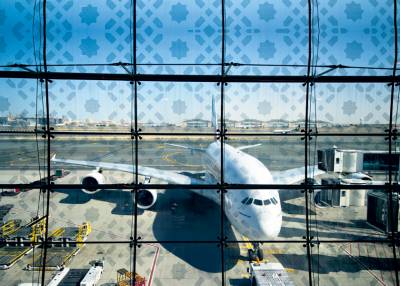Landing on an Emirates A380 flight from London, I realise that the view of Dubai from the air is every bit as fantastic as that of Manhattan: the Burj Khalifa, the world’s tallest building, punctures the clouds like a giant hypodermic, while reclaimed islands under development in the Arabian Sea are yellow polka dots of economic optimism. Peer through the heat haze and, out on the horizon, you can see something very impressive being built. It looks like a giant black hyphen in the desert and it pinpoints the start of the next big thing in global aviation, something that will herald the new jet age.
A line in the sand: the rise and rise of Gulf airlines
14th March 2015
With new airports being built in Dubai, Abu Dhabi and Doha, the combined might of Gulf airlines is set to oust European carriers from pole position, says John Arlidge
In just two decades, the Gulf carriers — Emirates from Dubai, Abu Dhabi’s Etihad and Doha-based Qatar Airways — have redrawn the skies. With new aeroplanes, fiercely competitive pricing, 24-hour operation at their hubs and new perks for passengers, including on-board showers, bedrooms and lounges, they have all but wrested the route from Europe to Australia from legacy carriers, such as British Airways, Air France and Lufthansa. Emirates, now in alliance with Qantas, has 18 flights a day from Britain to Dubai alone and on to every major city in Australia. By contrast, British Airways has one flight a day to Sydney and Virgin Atlantic has none.
Last year, Singapore lost to Dubai as the busiest stop for the Sydney-London route. Emirates, Etihad and Qatar also dominate travel from Asia to Africa and Latin America. Emirates flies to more than 20 major cities in Africa, more than any of the flag carriers of the old colonial powers and more than most African airlines. The Gulf airlines are now even daring to nibble at the European and American carriers’ lunch — the lucrative trade routes to and from the US. Big, new fuel-efficient jets, notably the A380, make it economic to run services to North America from the Middle East.
Travellers from Africa, south Asia and the Far East are now connecting to the US through the Gulf, rather than through European hubs as they have in the past. Peter Morris, chief economist at aviation consultancy Ascend, says the Gulf airlines “have now built enough critical mass to be a genuine threat to the traditional European airlines and hubs and, in the near future, to the Americans”. John Strickland, director of independent aviation consultancy, JLS Consulting, adds: “They are currently witnessing their moment in history.” Emirates is leading the Gulf pack and has grown so fast it is now the world’s largest international airline, flying more than 210m passenger kilometres a year, compared with 140m each for its nearest rivals, United and Lufthansa. Thanks to all this growth, Dubai International has just overtaken Heathrow to become the world’s busiest international airport, handling an expected 70 million passengers by the end of this year, compared with Heathrow’s forecast 67 million. Heathrow cannot increase its footfall because it operates at 100 per cent capacity. In contrast, by 2018, the number of passengers passing through Dubai International is expected to pass the 90 million mark. And that’s where that black line in the sand comes in. It is the first of five one-mile-long runways that will eventually form the world’s largest airport — the $82bn Al-Maktoum International or World Central, as Dubai airport executives (modestly) call it. When complete, it will be a 140sq km airtropolis handling more than 160 million passengers a year. “It will be the world’s largest airport,” says Paul Griffiths, who runs Dubai airports. “By 2025, more than 160 million travellers a year will pass through it and Dubai International, which together will have seven runways.” You can almost hear Heathrow’s bosses weeping. Griffiths, a former Virgin Atlantic executive who used to run Gatwick airport, is not the only Brit building runways in the sand. Seventy miles down the motorway from Dubai, in Abu Dhabi, Tony Douglas, a mountain of a man who used to be in charge of Heathrow, commands what he calls “an army of more than 16,000 men, 42 tower cranes and 35 mobile cranes”. Douglas is building another vast new hub to replace Abu Dhabi’s existing airport that is too small and too old to cope with Etihad’s vast expansion. James Hogan, Etihad’s boss, placed orders for 199 aircraft worth $67bn at catalogue price last year, adding to plans outlined six years ago to buy 205 passenger jets. All of which delights Douglas. “The airlines are growing so quickly, we can hardly keep up with the infrastructure,” he says, as he shows me around the world’s largest building site. “It’s the type of problem that every airport operator dreams of.”
Abu Dhabi’s new airport will handle 30 million passengers a year and have exciting new features: a “mini-America” will offer pre-visa clearance for passengers travelling to the US and there will be a museum to highlight the emirate’s cultural attractions, such as The Louvre Abu Dhabi, which opens in two years’ time. And, as if all that airport construction wasn’t enough, Qatar Airways’ new home, Hamad International in Doha, has just started its first flights. It will handle 30 million passengers, rising to 50 million by 2018, as Qatar Airways expands. The airline currently has orders worth more than $70bn for in excess of 330 aircraft, including Boeing 787s, 777s, Airbus A350s, A380s and A320s.
Put it all together and, by 2017, the world’s three newest airlines will have the best and, in Emirates’ case, the largest, long-haul fleets in the world and brand new home hubs. There will be four massive airports in an arc around the Arabian Sea, running from Dubai International, through Al-Maktoum and on to Abu Dhabi and Hamad International. Their combined capacity will be more than 300 million passengers a year. The move is the biggest air and land grab in the history of modern travel. If it works, the Gulf carriers will dominate the business of getting from A to B, creating a new jet age. As Peter Morris, chief economist at Ascend, puts it: “We’re seeing a change in the historic global balance of power.” Are the legacy carriers worried? You bet. European airlines have long criticised Gulf airlines. First they claimed the spendthrift sheikhs were playing aeroplanes in a place “where nothing exists besides sand and a box of money”, as former Lufthansa boss Christoph Franz put it. Then they said the airlines enjoyed unfair state subsidies and cheap fuel. Now, realising they cannot beat the new world airlines, old world carriers have decided to join them. Willie Walsh, boss of BA’s parent company IAG, recently welcomed Qatar into BA’s Oneworld alliance. “Becoming a member of Oneworld is one of the most significant landmarks in Qatar Airways’ history,” says Akbar Al Baker, the airline’s chief executive, with glee. Less than 20 years after it bought its first jet, Qatar is partnering with the oldest global airline in the world. It raises a big question: will there be enough well-dressed bums to fill the Gulf carriers’ well-upholstered seats and to throng all the new marble and glass monuments to a world in motion? In Abu Dhabi, Douglas has no doubts.

“Am I concerned that when we open, we’ll see tumbleweed blowing along the runways, empty departure halls and an aircraft control tower with everyone reading the paper? No, no and no. We can’t get the airports open soon enough.”
Tim Clark, boss of Emirates, which already has 224 aircraft and a further 300 more on order, worth $138 billion at list prices, adds, “We are within eight hours’ flying time to two-thirds of the world’s population — a population that is getting wealthier and more inclined to travel than at any time in human history.” Analysts agree. The number of flights to and from the Gulf is expected to double between now and 2030 to more than 1.6m a year, says the International Air Transport Association. Airbus forecasts that in 20 years Dubai will rank just behind Beijing and Hong Kong as a centre of world air traffic, while Boeing says the United Arab Emirates will become the world’s third market for air travellers after the United States and China. The Gulf airlines are set to post net profits of a combined $2.4bn in 2014 — a 50 per cent increase over the 2013 prediction of $1.6bn. Passenger numbers are expected to grow by an average of 5.4 per cent a year until 2017. If you doubt the airline folks’ optimism, it pays to linger a while after your flight lands at Dubai. Rush hour starts late. Between 10pm and 1am, Emirates’ airliners rain down on Dubai International — 100 land during this frenetic three-hour period. Watch the conga lines of A380s land from Europe and take off again for Asia and vice-versa; see the destinations ping down the departure screens, from Abidjan to Zanzibar, like a Vegas slot machine. It’s hard not to marvel — and conclude that the world has a new crossroads.








